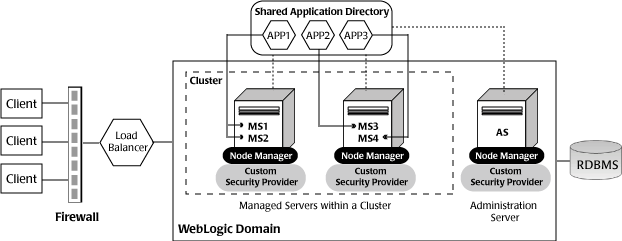







|
This document describes the procedures to upgrade your application environment to WebLogic 10.0. An application environment includes applications, the WebLogic domains in which they are deployed, and any application data associated with the domain, and may include external resources, such as database servers, firewalls, load balancers, and LDAP servers.
WebLogic 10.0 includes powerful tools to assist you with upgrading your application environments including the WebLogic Upgrade Wizard for upgrading domains, custom security providers, and custom node managers.
Most WebLogic Server applications can be run without modifications in the new WebLogic Server 10.0 application environment.
The following sections provide an overview of the topics discussed in this chapter:
We recommend that, before proceeding, you familiarize yourself with the following terminology:
The process required to upgrade an application environment depends on the scope of the application. An application environment includes a WebLogic domain and any applications and application data associated with the domain. It may also include external resources, such as firewalls, load balancers, and LDAP servers. Figure 1-1 shows an example of a WebLogic application environment.

The following table lists the components of the WebLogic application environment shown in Figure 1-1, and the upgrade requirements for each.
Includes the Administration Server (AS) and optionally one or more Managed Servers (for example, MS1, MS2, MS3, and MS4). The servers in a domain may span multiple machines. Furthermore, you can group Managed Servers into clusters to support load balancing and failover protection for critical applications. For more information about WebLogic domains, see "Understanding WebLogic Server Domains" in Understanding Domain Configuration at
http://download.oracle.com/docs/cd/E13222_01/wls/doc100/domain_config/understand_domains.html.
|
||
Supports custom security requirements. For information about developing custom security providers, see Developing Security Providers for WebLogic Server at
http://download.oracle.com/docs/cd/E13222_01/wls/docs100/dvspisec/index.html.
|
||
Provides high availability to Managed Servers. For more information about Node Manager, see "Using Node Manager to Control Servers" in Managing Server Startup and Shutdown at
http://download.oracle.com/docs/cd/E13222_01/wls/docs100/server_start/nodemgr.html.
|
||
Any Java EE applications, including Web applications, EJBs, and so on. Typically, applications are deployed to one or more Managed Servers in a domain. Depending on the deployment strategy, applications may reside locally on a machine or be accessible via a shared directory. In addition, external client applications may access the application environment from outside a firewall.
|
Most WebLogic Server applications can be run without modifications in the new WebLogic Server 10.0 application environment. For more information, see Interoperability and Compatibility with Previous Releases.
|
|
The WebLogic Upgrade Wizard guides you through the steps required to upgrade a WebLogic domain that is compatible with WebLogic Server 7.0, or 8.1 such that it runs in a WebLogic Server 10.0 application environment. As part of the upgrade process, you must upgrade any custom security providers and Node Managers used in the domain.
You can also use the WebLogic Upgrade Wizard to upgrade a WebLogic domain that is compatible with WebLogic Server 9.0, 9.1, or 9.2 to 10.0, but this is optional. This type of domain runs under WebLogic Server 10.0 without modification.
You can step through the upgrade process interactively, using the graphical user interface (GUI), or "silently," by creating an upgrade script and running it. Note that the Silent Mode is supported for upgrading WebLogic Server domains only.
Application environments that run with WebLogic Server 10.0 can interact with application environments built on WebLogic Server 7.0, 8.1, or 9.x.
Most existing WebLogic Server applications can be run without modification in the new WebLogic Server 10.0 application environment. You should review the compatibility information described in WebLogic Server 10.0 Compatibility with Previous Releases to determine whether any feature changes affect the applications in your environment. If your application uses APIs that have been deprecated or removed, then you may encounter warnings or exceptions at run time.


|